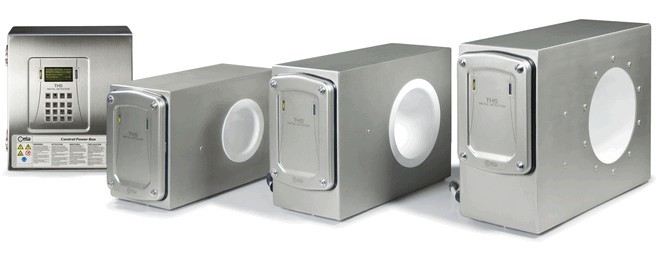
The CEIA MS21 Multispectrum Metal Detector
The CEIA MS21 Multispectrum Metal Detector
To understand the difference between CEIA’s unique multi spectrum technology and the multi frequency metal detectors that are also available, we need to first review the metal detector’s function in an industrial process.
Metal detectors are there to protect both the product that the consumer receives and the equipment used in manufacturing the product. They need to be able to detect ferrous, non-ferrous and stainless steel particles of various sizes.
The disturbances to the electromagnetic field caused by these various contaminants are how the detector identifies them and then activates the reject system to remove them or alert the operators.
Product Effect
Some products contain salt, iron and moisture which will also alter the detector’s field and can trigger a false detection. This effect increases with higher inspection frequencies that are typically used to detect smaller particles and can lead to significant levels of wasted product and downtime.
It is not uncommon to find detection frequencies reduced to minimise the number of false detections but that has the additional impact of reducing the ability of the detector to identify 316 s/s and non-ferrous contaminants.
Metal Detector Types
There are 3 main technologies used in metal detection:
- Single Frequency Metal Detectors: these are the most basic type with limited abilities to work with different products and difficult to optimise for varying conditions of temperature, water content and packaging types.
- Multi Frequency Metal Detectors: these units operate with multiple frequencies so the same unit works with a variety products that have a range of characteristics. However they still only operate with one frequency at a time meaning that the product effect can still impact their performance.
- Multi Spectrum Metal Detectors: these detectors overcome these issues by operating over an entire spectrum of frequencies that are simultaneously applied giving a much improved inspection of the product.
CEIA MS21 Multi Spectrum Metal Detector
With a sophisticated autolearn function the MS21 replicates the effects of hundreds of conventional transits and allows the detector to recognise the different responses of conductive products and metals, cancelling out the product effect and giving a consistently high performance.
The advantage of this is that it can give an increase in sensitivity against a conventional metal detector of up to half the diameter in test sample size. As an example, half the diameter is an eighth of the volume, this means the MS21 can be up to 800% more sensitive in terms of volume than a standard frequency metal detector. This gives it an incredible advantage over a standard system in finding small irregularly shaped contaminants. In addition, because the MS21 works across a spectrum, it can also work effectively with non-homogeneous products that have a range of different signal phases, not just one.
The CEIA MS21 constantly self-tests to adjust its detection characteristics maintaining its stability and performance.
Arrange a Test
If you are developing a new product, we would be happy to arrange a test with an MS21 to demonstrate its abilities. Please contact us for an initial discussion or if you would like further information on the MS21 unit.
